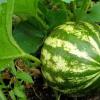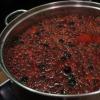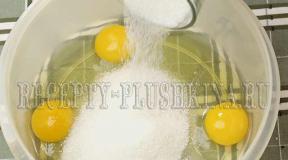Storing sauerkraut in the refrigerator. Where to store sauerkraut
Easy to prepare sauerkraut... It is much more difficult to save it. Therefore, the question of how to store sauerkraut at home, so that it does not lose its taste and useful properties, often worries housewives. Of course, the best way- it is fermented in small portions as the salting is consumed. But what if fresh vegetables there is nowhere to store, and prices for vegetable crops in winter bite? This article will come to the rescue.
It is best to store sauerkraut at temperatures close to 0 degrees. Of course, temperatures up to 10 degrees Celsius are also suitable for short-term storage. But in this case, the fermentation processes will continue, and the cabbage will peroxide.
That's why the ideal temperature would be between 0 and +3 degrees Celsius... This temperature can be found in a refrigerator or cellar. A glazed loggia is also suitable if the mercury column does not fall below zero there.
Freezing
It should be noted right away that the process of freezing and subsequent defrosting of sauerkraut destroys a significant part of vitamin C. Therefore, if freezing turns out to be an urgent measure, the product should be eaten immediately after it thaws.
If this does not work, for example, due to the large volume, then it is strongly not recommended to re-freeze the product. If you decide to freeze the cabbage, then it is advisable to freeze it along with the juice or brine that has come out. Or at least keep the brine in the bottle. Why? More on this later.
Capacity
If you are going to store sauerkraut for a long time, then you should pay attention to the container in which it is placed. Our ancestors often used oak tubs and barrels for these purposes. This is, of course, a way out.
But a pickled vegetable will significantly lose its unique taste if it lies in a barrel that smelled of damp basement or unpleasant amber of an old tree. Therefore, stopping at a wooden container, make sure that it does not smell of anything and does not spoil the taste of your preparation for the winter.
Do not store pickles in aluminum or steel dishes. Oxidation processes will impart a persistent metallic flavor to the food. This is not only not tasty, but also terribly harmful.
The best storage container would be enamelled or glass container... Stop your choice on her!
Do you need a pickle?
Sometimes housewives pour the brine from sauerkraut and store pickles without brine in the refrigerator. In no case should this be done. Storing sauerkraut exactly in brine it is necessary for to keep vitamin C from degrading quickly. Therefore, it is worth making sure that the cabbage only gets into the brine.
When stored without brine, the end consumer is unlikely to be able to notice significant changes in the taste of the product. However, salting will become much less useful than it was originally. Stored without brine, the product in question inevitably loses its usefulness for the human body. This means that cabbage should be removed from the brine immediately before eating.
The same vegetable that remains in the container must be pressed well so that all of it is immersed in the brine. For this, it is advisable to use oppression. A can of water placed on a plate can act as it.
Can sauerkraut be kept warm?
Sometimes the hostesses have a desire to store sauerkraut in a warm room. For example, in a room or even in the kitchen. Can this be done? You will be surprised, but yes! You can do that. You just have to sprinkle the product with granulated sugar at regular intervals.
This need is due to the fact that granulated sugar getting into an acidic environment, it turns into vinegar. He, in turn, protects the cabbage from decay.
If the pickles are too acidic, you can also lightly sprinkle sugar on it before serving. Excess acidity will disappear, and all vitamin C will remain.
In addition, if possible, cranberries or lingonberries should be added to the container with sauerkraut. They remarkably help the workpiece to be preserved as long as possible without losing its useful properties.
The only possible disadvantage of keeping pickles warm is the frequent appearance of mold. But this can be avoided.
How to prevent mold from growing on sauerkraut?
During storage of sauerkraut in salting containers, plaque often forms on the surface white that looks like mold. This plaque is indeed a mold, the appearance of which is provoked by the activity of yeast fungi. Such mold can categorically affect pickles Negative influence, turning it into a loose and completely tasteless product.
Help get rid of negative impact mold capable of such simple and accessible to everyone products as horseradish and mustard. When handling products placed in a jar or barrel with mustard powder, everyone has an excellent opportunity not only to protect saline from mold formation, but also to give it an excellent, rich and varied taste.
Not only powder can help, but also mustard seeds. They should be wrapped in bandage or gauze and placed in a container along with sauerkraut, which must be protected from mold. Try to place such a bag as deep as possible in the barrel so that it is located closer to the middle of the pickle.
Horseradish is also capable of preventing the appearance of mold. The root shavings of this plant, when added to the container, help prevent unwanted chemical reactions that cause mold to form on the surface. Only add horseradish to pickles after the cabbage is fermented. Otherwise, the fermentation process may not occur, and the vegetable will only be salted if there is enough salt for this.
So that is all. Now you know how to store sauerkraut at home and how to protect pickles from mold. It remains only to note that sauerkraut is much more useful than pickled cabbage, since the process of conservation itself destroys great amount nutrients contained in the vegetable. Boiling and other types heat treatment destroy nutrients. And the vinegar added during canning has no health benefits.
Sauerkraut is considered a source of vitamin C, as well as useful minerals that the body especially needs in winter time of the year. You can try and buy any of the types of this snack in the market. After its preparation, the question arises: how to store sauerkraut at home? It must be understood that this product is produced by fermentation. Thus, if you do not follow the rules for storing sauerkraut, it will quickly deteriorate.
Can sauerkraut be stored?
How to store sauerkraut at home - blanks
Remember that cabbage is not fermented using aluminum and plastic containers... The lactic acid released by the vegetable during fermentation will oxidize aluminum. Thus, the product will have an unpleasant metallic taste.
How to store sauerkraut: rules
It is believed that such cabbage is healthier than fresh, since all useful substances disappear over time if the product is not prepared in a special way. V sauerkraut due to lactic acid, vitamins remain. You just need to know the basic rules for storing it:
- Feel free to freeze your sauerkraut if the need arises. After thawing, it should be eaten immediately, because after a while the useful substances will evaporate from there.
- It should be kept tiny in a container filled with brine. Without it, the specific flavor of cabbage disappears, and vitamin C is destroyed. Get the vegetable out of there before eating, otherwise it will lose its value.
- The shelf life of cabbage is increased by adding cranberries to it. You can sprinkle 1-2 tbsp of cabbage on top. l. sugar, which then turns into vinegar. The latter is an additional preservative.
- The mold formed on the crumb is carefully removed. Then mustard powder is added to the cabbage. He acts as an antiseptic.
How to store sauerkraut so that it stays tasty and retains all of its beneficial features? This question is relevant primarily for those who buy a product in large quantities or independently engaged in pickling cabbage in reserve. Storing sauerkraut is not so difficult, but still there are clear requirements, observing which you can provide yourself with this product for many weeks in advance.

Traditional container for pickling cabbage - wooden barrel
What factors affect the quality and shelf life?
Cabbage variety
Much depends on the type of cabbage. Fermented cabbage of mid- and late-ripening varieties is well preserved. It is she who ferments for a long time and retains a pleasant crunch and dense texture. Early ripe cabbage varieties are distinguished by the tenderness of the leaves and are more suitable for making salads or light soups, and it is better not to use them for preparations. Such cabbage will resemble boiled cabbage in consistency, and this is unacceptable in this case.
Cabbage varieties for pickling or pickling usually have juicy and very dense leaves with thin veins, which can be difficult to chop. The color of such heads of cabbage is very light, almost white. Vegetable with green leaves It is in no way suitable for fermentation, for such a preparation will most likely taste bitter.
Note: if you do not chop the leaves into thin strips, as is usually done, but cut into large (up to five cm) squares, then the amount of stored vitamins will be maximum.

Early maturing varieties are not suitable for sourdough, like green leaves.
Storage container
You should not store sauerkraut in an aluminum container, as a reaction between the metal and the acid will begin, as a result of which the product will turn black and begin to taste bitter. Eating such a dish will be not only unpleasant, but also dangerous to health. Glass or enamelled containers are the most suitable option.
Temperature and humidity
The storage conditions for pickled or sauerkraut cabbage are similar in terms of temperature, the ideal is considered to be from +2 ˚C to +5 ˚C. At elevated temperature storing cabbage will not work: it will quickly turn sour.
You can also freeze the product if it is not possible to save it in ideal conditions, it is better to do it in portions. In addition, it must be remembered that repeated freezing will be fatal for the product. but also very undesirable.
The storage temperature should be constant. It is recommended to store sauerkraut at a sufficiently high humidity; excessive dryness does not benefit this dish.
Mold protection
Late varieties of cabbage can be stored in fermented the longest - up to six months, especially in the cellar, adding cranberries or lingonberries to the treat, which will help prevent mold. Mustard and its seeds have the same properties, as well as sugar if sprinkled on the finished product from time to time.

White cabbage is suitable for sourdough, giving best result to taste and storage
Brine quantity
Sauerkraut or pickled cabbage should be stored so that the brine completely covers the shredded leaves. If it is not enough, add to the container with the workpiece required amount cool water with added salt. Cabbage fermented in large containers is specially pressed down with oppression, because only being in the brine, the product will retain that incredible amount of vitamin C and other useful substances that it contains.
Useful advice: if the cabbage harvest is ripe in the beds for storage in sauerkraut, then these heads of cabbage can not be removed until the first light frosts. In vegetables picked up by the first frost, starch is converted into sugar, which gives their pulp a brighter and richer taste.
Best storage space
Cellar
Where to store cabbage if it is fermented in large quantities? The best option- in the cellar, in wooden barrel, as has been the custom for a long time. Nowadays it is not easy to get such a container everywhere, so enameled buckets, tanks or deep basins are perfect. Solid cellar, processed special means against mold and rot, protected from the invasion of omnivorous rodents, will keep sauerkraut at its best!
Balcony
Is it possible to store sauerkraut in the apartment? Sure! One of the options is harvesting cabbage for the winter in jars for long-term storage on the balcony. It is very convenient to store sauerkraut in jars, because these containers come in different sizes, and besides, the product is stored in sterilized jars just fine! Banks can be wrapped in a blanket or something else warm to protect from severe frost.
In principle, a whole barrel of sauerkraut can be stored on the balcony, but if the product freezes, then the portion taken for defrosting and on the table will need to be consumed in the near future, and freezing again is perhaps the worst thing that can be done ... Well, if the balcony is at least slightly insulated, then it can become an excellent storage not only for sauerkraut, but also for other preparations.

Traditionally, we shred cabbage for pickling in small narrow strips, but a larger shredder retains more vitamins.
Plastic containers
At the owners who do for the winter a large number of vegetable and fruit and berry preparations, all glass jars in abundance! Sometimes it happens that this container runs out, and then the owners try to get by with plastic dishes: cans and even plastic bottles are used, the neck of which is cut off. It is not uncommon to find sauerkraut in similar packaging on the market aisles.
I would like to note right away that the workpiece will be stored in plastic containers and cans for a much shorter amount of time than in glass, so it is better to destroy such stocks in the very first place.
In addition, everyone knows how unpleasant plastic smells and how quickly this corrosive smell is transmitted to food with which such dishes come into contact. In short, this option is only suitable for short-term storage in the refrigerator.
Fridge
How much sauerkraut is stored in the refrigerator? At the appropriate temperature, it will stand for about the same time as in the cellar, without spoiling and without losing its taste and useful qualities... The refrigerator is great for storing sauerkraut for months, but who on earth would wait that long before feasting on such a wonderful dish?
Storing it in the refrigerator has only one drawback: not enough free space. It is clear that no one will keep a bucket with the workpiece in the refrigerator, because then there will be nowhere to store all the other products. A couple of three-liter glass jars is the maximum, and it is important to keep the jars closed in order to prevent the penetration of foreign odors, which will quickly be absorbed into the product and spoil its taste. It will be especially unpleasant to eat cabbage with a flavor. smoked fish or sausages.
Storage outside the cellar and refrigerator
There is great recipe, allowing you to store as much sauerkraut as you like in an apartment with room temperature.
- Cabbage - 5 kg.
- Carrots - 3 pieces.
- Table salt - 90 g.
- Granulated sugar - 80 g.
- Bay leaf (optional) - 5 pieces.
By the way, sugar can be replaced with honey, then the dish will turn out to be even tastier!
Preparation:
- The upper damaged or greenish leaves are removed from the heads of cabbage, stubs are removed, the vegetable is chopped with a thin long straw... Carrots are rubbed on a coarse grater.
- Prepared vegetables are thoroughly mixed in a clean deep enamel bowl along with all the spices and tamped very tightly.
- They put oppression on top: a wide plate turned upside down and a jar of water. In this form, the workpiece is left to ferment for 3-5 days, until fully cooked.
- Banks with a capacity of 1 liter are prepared by steaming, after which the sauerkraut is laid out on them, leaving three centimeters to the neck.
- They put cans covered with lids in a large pot with warm (not hot!) water, closing them not to the very top (3 cm to the neck), include medium fire... As soon as the water in the pan boils, the heat is reduced to a minimum and the workpieces are sterilized for 40 minutes. There should be a towel at the bottom of the pot, if there is no special wooden support. Sterilized cans are carefully removed from the water using oven mitts and rolled up as quickly as possible.
The resulting canned food will not deteriorate and will remain tasty, even if it will stand until summer at room temperature. Such cabbage can not only be used as vitamin salad, but also cook delicious sour cabbage soup from it or even stew with meat.
And if you have a little left whole carrots then you might be curious to know, and if so, how best to do it.
Regardless of whether you bought sauerkraut or cooked it yourself, you need to know how to store it correctly. If you do not provide the product with elementary conditions, it will turn sour or dry out in just a few days. In both cases, the dish will no longer be suitable for food. The rules for maintaining the product are very simple and easy to implement even at home. In addition, there are several nuances, the observance of which will minimize those minor risks that remain with the right approach.

Where to store sauerkraut?
First of all, you need to decide where you can keep ready-made cabbage... Here, the following requirements for environmental indicators come to the fore:
- Temperature. If possible, the workpiece should be stored at 0 ° C. The maximum allowable indicators are 2-5º. It is better not to keep the dish at negative temperatures, this can lead to the destruction of vitamins and a change in the texture of the vegetable.
- Lack of light. Direct sunlight leads to the destruction of vitamins and trace elements in the composition of the dish. Ideally, the location you choose should be dark.
- Humidity. If this indicator will be less than 60%, there is a high probability that the upper part of the masonry will begin to dry out. As a last resort, you need to constantly monitor the level of the brine in the storage container.

Tip: If possible, cabbage should be packaged in small containers. The workpiece does not tolerate temperature changes, and its constant movement from cold to warm in order to feed a small part to the table can lead to the fact that the entire mass ferments and disappears.

It turns out that the ideal place for storing the product is a basement or a cellar. In a city apartment, a balcony (in cold months) or a refrigerator can be adapted for these purposes. Sauerkraut should not be kept in close proximity to other foods. She herself has a strong aroma and absorbs other odors very actively. If it is not possible to store the workpiece separately, you need to at least take care of high-quality dishes.
How to choose utensils for storing sauerkraut?
Most often, at home, housewives keep ready-made cabbage in glass jars... it great option, but far from the only one. You can count on the same result when using basins, metal containers, wooden tubs.

Particular attention should be paid to the filling of the selected dishes:
- First, lay out the bulk, then pour in the brine. It must completely cover the product, otherwise it taste properties noticeably suffer.
- If there is little brine and it does not completely cover the cabbage, the workpiece should be stored under a press. When this does not help, a little salt water should be added to the mass.
- To prevent mold from appearing in the stocks, a little sugar, mustard powder or cranberries with lingonberries should be added to them.
- Coarsely shredded vegetables are stored better. Even after a few months, it retains a lot of useful components.

When you want to cook sauerkraut and long time forget about it, you should spread it out in sterile jars and close it by holding additional sterilization... True, in this case, the workpieces will lose some part of the vitamins and microelements.
There are a number of nuances, the observance of which will allow you to store ready-made snack as long as possible. At the same time, she will continue to delight her fresh taste and a clean scent.
- The cabbage can be frozen. With this approach, she absolutely does not lose anything. The only disadvantage of this approach is that you will have to defrost the mass naturally, and this takes time. Products cannot be re-frozen. And after thawing, the snack should be consumed within 1-2 hours. It will not be possible to place it for longer storage, even in the refrigerator.
- Cranberries, sugar and lingonberries not only reduce the risk of mold in the workpiece. They also contribute to the formation of a natural preservative in the brine, which increases the shelf life of the component.
- If for some reason it was not possible to store the cabbage according to all the rules and traces of mold appeared on its surface, you do not need to throw away the entire stock. It is enough to remove the formed film and remove the spoiled products. After that, add a little mustard powder to the brine and mix everything thoroughly. Acting as an antiseptic, this component will eliminate the likelihood of reappearance mold fungi... At the same time, the taste and aroma of the workpiece will not suffer or even change.

The given universal rules and recommendations do not always work. If during the preparation of sauerkraut some unusual ingredients, such as apples, were used, the shelf life of the workpiece may change. Here you will have to act at your own peril and risk, choosing the optimal place and conditions for keeping dishes.
Experts recommend adhering to basic recommendations and making changes only if signs of deterioration in cabbage quality appear. If no methods have helped and from food product a characteristic sour smell began to emanate, it is better not to risk the health of your family and just throw it away.
In case of controversial situations, it is better to resort to sterilization of spins. Although this will reduce the number of useful components in the workpiece, it will at least make it safe and ensure the maximum shelf life.
The hostesses have many recipes for cooking delicious dishes from cabbage, which are suitable not only for everyday lunch, but also festive feast... How to properly store this useful and beloved by many vegetable?
How to prepare cabbage for long-term storage
At correct organization process, compliance with a number of conditions, cabbage can lie until spring, while not losing valuable properties and taste qualities.
Several practical advice for preparing cabbage for long-term storage fresh:
- Start harvesting heads of cabbage in October. By this time, they will already become tight and dense.
- Chop kale in dry weather. Leave the leg long if necessary, depending on the storage method chosen.
- Manage to remove the heads of cabbage before the onset of the first frost.
- Inspect the forks, remove any that have damage, signs of rot or pest moves. Medium heads of cabbage have the best keeping quality, they are the least susceptible to cracking.
- Peel off the cabbage by removing excess leaves and leaving a couple of green covering leaves, which will protect the head of cabbage from mechanical damage and excessive moisture evaporation.
Note: not all varieties of white cabbage are suitable for long-term storage, but only medium-late and late types.
The ideal vegetable storage will be a dark, cool place where the air temperature will be maintained in the range from 0 to -2 ° C. This can be a cellar or basement.
7 ways to keep fresh cabbage until spring
Exists different ways allowing you to keep the cabbage intact for long time... Here are just a few of them:
1. Wrap each forks in several layers of cling film. Place on shelves in storage, preferably staggered to ensure a constant flow of air. Thus, the heads of cabbage will last up to 4 months.
2. Pour wet sand into the bottom of the cellar, stick cabbage forks into it, stumps down. The stalks must be long, and the head itself must be cleaned of excess leaves.
3. Cabbage is well preserved in a suspended state. The long leg is wrapped in twine and fixed on the poles under the ceiling. This ensures excellent ventilation and reduces the risk of rot.
4. Store the heads of cabbage without a long leg on wooden shelves. Lay them stump up, in loose rows. Additionally, you can wrap each fork with paper. But in this case, do not forget to regularly check the vegetables, remove the damp wrapper, wrap it in a new one.

5. Use wood boxes for storing cabbage. Place the vegetables in two rows: the first stumps should look up, and the second, on the contrary, down.
6. "Preserve" the cabbage forks with clay. To do this, clear the heads of cabbage from the top sheets, wrap the stumps with twine. Hang the cabbage outdoors under a canopy, head down on the bar. Dilute the clay to a thick, creamy consistency and coat each fork with it. Make sure that there are no gaps, the head of cabbage was covered with a layer of clay. Leave the vegetables until the clay dries well, then transfer the cabbage heads to the cellar, where they hang.
Clay creates a kind of cover that reliably protects the vegetable from damage, rot, disease, wilting.
7. For those who do not have a cellar, there is the same good option for storing cabbage. Dig a hole 1 meter deep in the garden bed. Place a layer of straw on the bottom. Lay the forks with stalks facing up, cover with earth, throw in a layer of hay, straw or any plant debris.
Short term storage
You can easily save this vegetable in an apartment for 2 weeks. To do this, place the cabbage forks in the refrigerator, but first you need to do the following: roll each head of cabbage in cling film, in 2-3 layers, and place in the fruit and vegetable compartment.
Until the first frost is established, cabbage can be kept on the balcony. For this, the forks are put into bags.
You can freeze some of the cabbage: cut the vegetable, put it in plastic bags and send it to the freezer. This cabbage is great for making soups: borscht, cabbage soup.
How to store sauerkraut

The fermentation process involves the active participation of microorganisms. It is thanks to them that the fermentation of the product occurs. Sauerkraut includes several successive stages, following a number of conditions. So, the product is kept in a warm room for several days, stirring to remove the gases formed during fermentation.
We recommend storing ready-made sauerkraut at about 0 ° C. But even if temperature regime will not be respected, the cabbage will not spoil anyway. With more high temperature the fermentation process continues, resulting in the characteristic sour taste of the cabbage. In this case, it must be rinsed several times with water before use. Freezing and thawing of food may cause some loss of vitamin C, especially when re-freezing.
The best place to store sauerkraut is in a dark, cool room, such as a cellar. You can also leave cabbage on the balcony, provided the temperature is low, and also place it in the refrigerator. The shelf life of the product is up to 1 year.
For storage containers, use the ones you like best: glass jars, pots with tight-fitting lids, wooden containers. The main condition is that sauerkraut must always be in the brine, otherwise it will dry out or darken, and lose its taste. To avoid the formation of mold, add a few sour berries (cranberries, lingonberries) or mustard seeds to the fermented product.
You can also store sauerkraut in the freezer using plastic containers. Do not forget that such a product cannot be re-frozen, so pack the cabbage in portions that can be consumed at one time.
Video
How do you store cabbage? Do you have your own secrets?
Read also ...
- Recipes for making coffee with ice cream at home
- Strawberry panna cotta - a classic of world culinary What is panna cotta with strawberries
- Cream of curd cheese for cake - the best recipes for impregnating and decorating dessert
- Profiterole recipe and three original custard recipes Protein cream for profiteroles


















